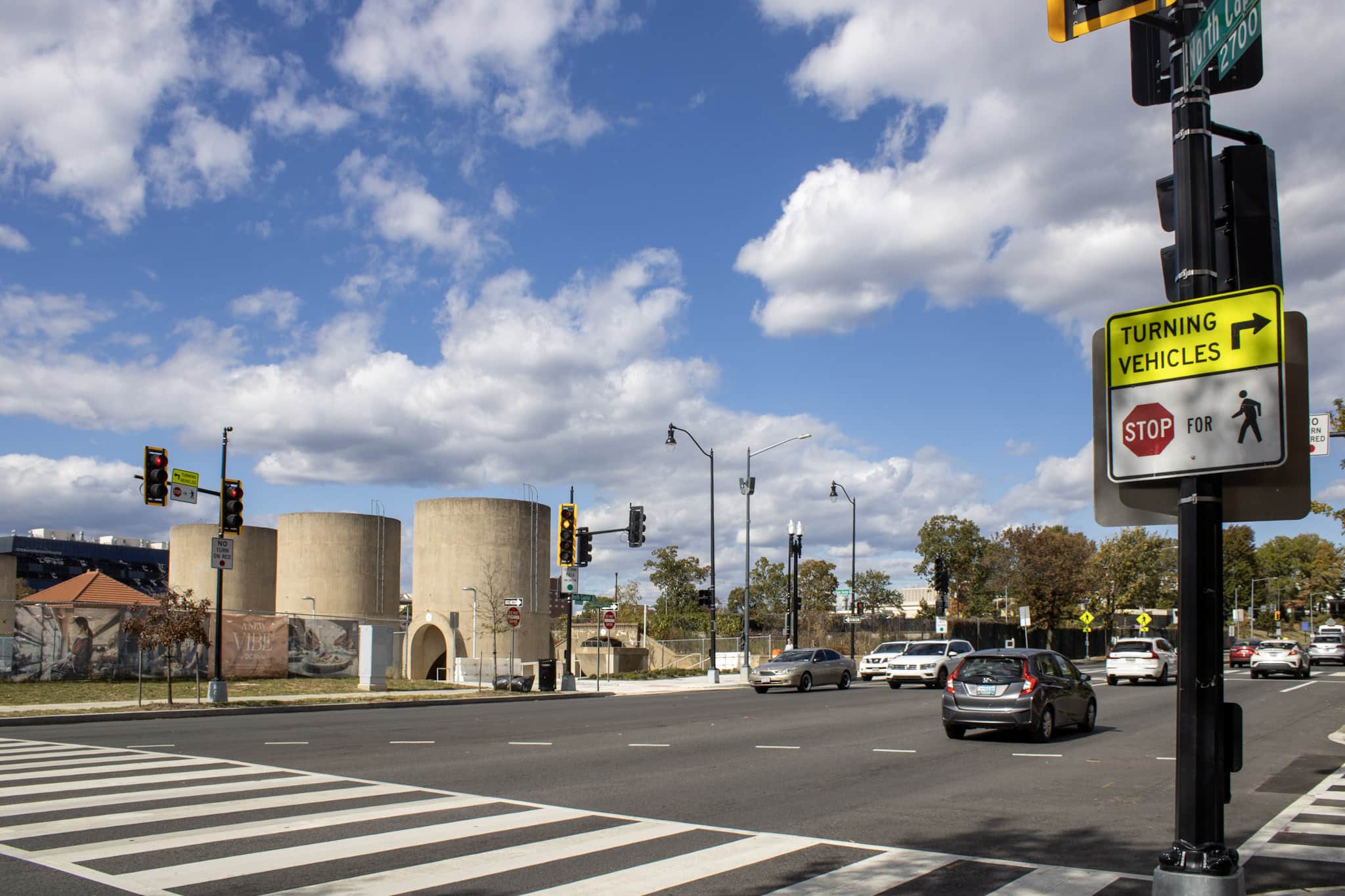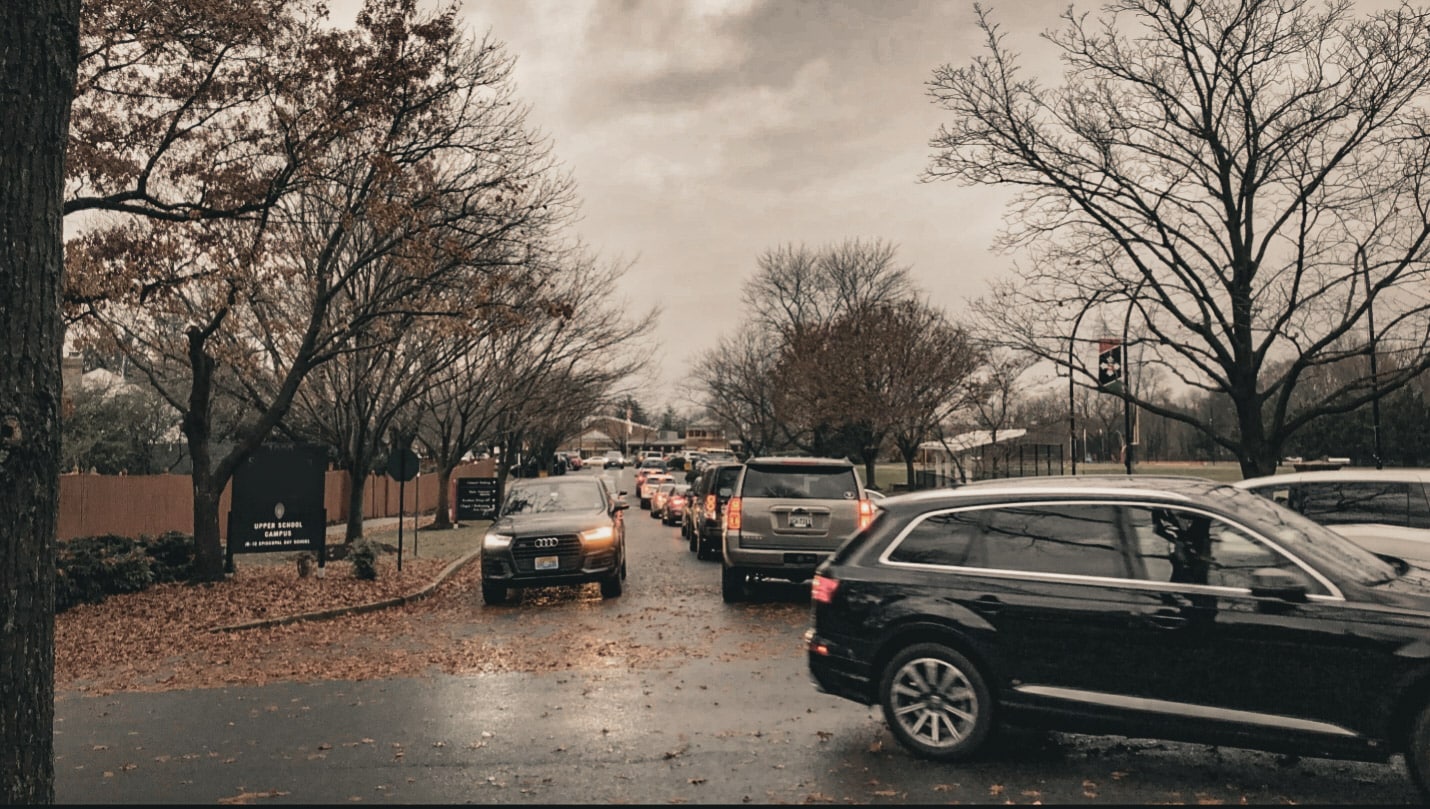
Smart Design Solutions for School Arrival and Departure
Insight Highlights:
- Student pick-up and drop-off (PUDO) is the aspect of school transportation that produces the most headaches for teachers, staff, parents, and neighbors
- In this post, we’ll be covering the factors that lead to long PUDO queues and the design elements and types of PUDO facilities
- This includes insights for transportation planners, school administrators, and K-12 school architects
Student pick-up and drop-off (PUDO) is the aspect of school transportation that produces the most headaches for most involved. It is the least efficient way of getting students to and from school compared to walking, biking, and traditional school buses. The number of personal vehicles that arrive at and leave a school in a short amount of time creates logistical problems.
This post highlights the lessons from Gorove Slade’s experience working with K-12 schools on planning and operating their PUDOs. That said, we want to reinforce that a high-quality PUDO system for a school should focus first on maximizing the number of students that walk, bike, or bus. The drawback of providing a high-quality school arrival and departure program is that it can encourage more parents to drive their children to school instead of having them walk, bike, or bus.
Regardless of the success in reducing the number of parents utilizing the PUDO option, schools need to be good neighbors and help minimize traffic overspill that can impact the surrounding neighborhood. To do this, they need a solid PUDO set-up and plan.
PUDO Queuing Factors
The factors determining how long vehicle queues are during PUDO at arrival and dismissal can be broken down into three categories: Demand, Operation, and Design.

Morning queues at a private school
Demand
The first factor is demand – the amount and concentration of students picked up and dropped off impacts queues. The percentage of students using PUDO is usually much higher in private schools, some neighborhood and choice schools depending on their busing policies/availability. Older students are also more likely to use non-vehicular modes: walking, biking, or taking public transit to school when it’s viable. The impact of before/after care programs and after-school activities is less obvious. The more students are enrolled in care or after-school activities, the greater the concentration of parents arriving simultaneously is spread out. When these factors are combined, private/charter elementary schools can have the largest concentration of PUDO demand per student, while public high schools have much lower queues per student.
Operation
Beyond the overall demand, operational and policy factors also significantly impact PUDO queuing. A critical factor is the level of staffing dedicated to PUDO operations, the number of teachers and staff that help run PUDO, and the amount of information disseminated to parents on preferred operations.
It is essential that the PUDO plan recognizes that arrival and dismissal are fundamentally different, as dismissal requires matching students to cars, while arrival doesn’t. This means that operational plans for both can be very different, with dismissal requiring more communication with the speed of student-to-car matching being key. Other operational factors include if a school breaks up dismissal times by grades or location to distribute demands over location and/or time.
A policy factor is if parents are allowed to ‘park and walk in’ to pick up their children instead of waiting in line and not leaving the car. This is often seen with younger students, where the lowest grades allow for some ‘park and walk in’, ideally via a separate PUDO area.
Design
Finally, numerous design elements impact queue length, as detailed below. The two most significant ones are (1) the number of cars that can load/unload at the same time and (2) the presence of alternative (informal) PUDO locations (e.g., if parents have other locations that they can use other than the ‘official’ location designated by the school).
PUDO Design Elements and Types
Whether planning a new PUDO facility or looking for ways to improve a current facility, there are 5 main design elements to keep in mind:
- Queuing Space: The number of cars that can queue up in the PUDO area on the school’s property/site. A school must keep the PUDO queues on-site to be a good neighbor. include using parking lot drive aisles or converting two-way drive lanes/aisles to one-way and double-stacked cars.
- Second/bypass Lane: In front of the PUDO area itself, a secondary or bypass lane can often be used. This allows for more flexibility in the type of PUDO operations during arrival and dismissal and is often used differently for each.
- School Staff: The number, location, and visibility of schoolteachers and staff influence PUDO operations.
- Sidewalk: The sidewalk along the PUDO area is vital, as it is often the most critical factor in how many cars can load or unload simultaneously. Gorove Slade’s most common recommendation to schools to improve their existing PUDO operations is to increase the number of cars that can load and unload simultaneously, often expanding the sidewalk in front of the school in the PUDO area.
- Student Queuing Area: The processing rate of cars during dismissal is a vital factor in how long queues get, meaning how quickly students get matched with the right car to pick them up. A student queuing area, sometimes in a room just inside the door next to PUDO or outside near where the cars wait, can speed up dismissal and reduce queues.
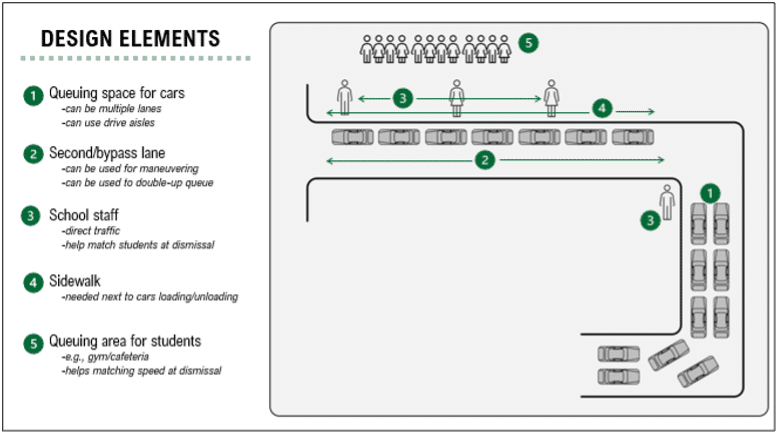
The major PUDO design elements
There are many ways PUDO facilities are operated during arrival and dismissal. In Gorove Slade’s experience, the following three types cover most pick-up/drop-off configurations.
Airport-style PUDO
What we call an airport-style PUDO is one that most drivers would be familiar with, where cars line up on a sidewalk to load/unload and then leave using a lane to bypass other vehicles. This works very well when long sidewalks are present, but its main drawback is how maneuvering cars into and out of spaces can be inefficient in the amount of space and time required. Variants of the airport type do not allow cars to bypass others and bring them in via platoon, like the scramble-style PUDO described below. Often, an airport-style PUDO is used this way (platooning) in the morning, maneuvering via the bypass lane for dismissal.
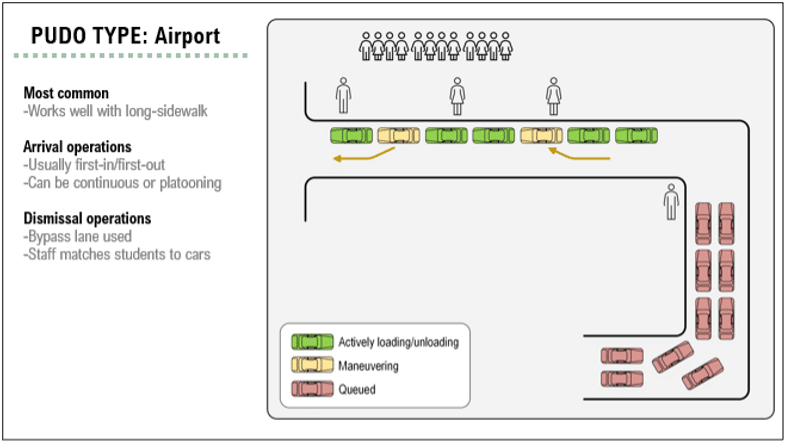
Airport-style PUDO
Tollbooth-style PUDO
A tollbooth-style PUDO is named after how toll booths only serve the cars at the front of the queue. It is usually not a preferred way to operate a PUDO and is employed when there’s a lack of adjacent sidewalks to allow multiple cars to load/unload. Because most loading/unloading only occurs at the front of the line, it does require less staff to run. Tollbooth-style PUDO facilities tend not to work well in dismissal because, for it to work, the cars in front need to be paired very quickly with their student, and a single delay can hold up the entire operation. In these situations, there is usually staff upstream in the queue communicating what students will be needed in the following few cars.
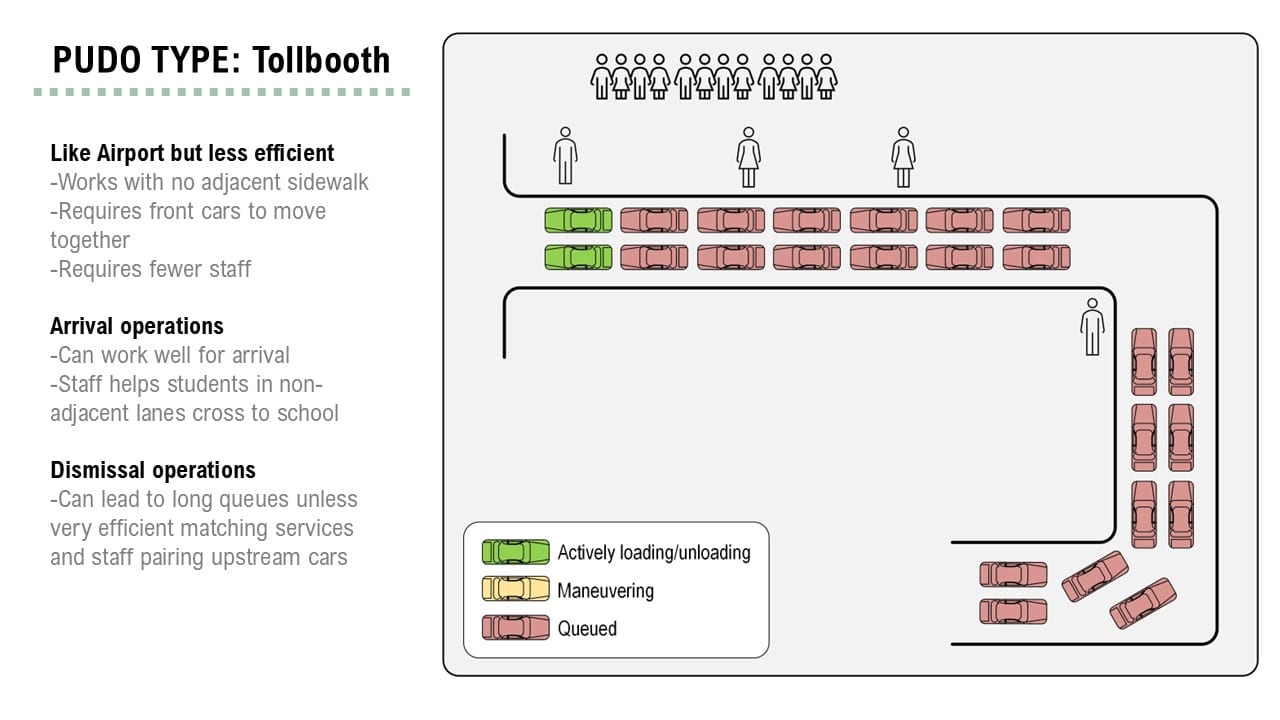
Tollbooth-style PUDO
Scramble -style PUDO
A scramble-style PUDO refers to when some (or all) students are being dropped-off or picked-up into the street and not an adjacent sidewalk and walking between cars. For scrambles, a portion of cars drive into a designated area, and then they all stop and don’t move again until all students are safely in the school on arrival, or in their car at dismissal. Scrambles are often used during dismissal for schools that have limited sidewalks, since a scramble allows for more cars to load at the same time.
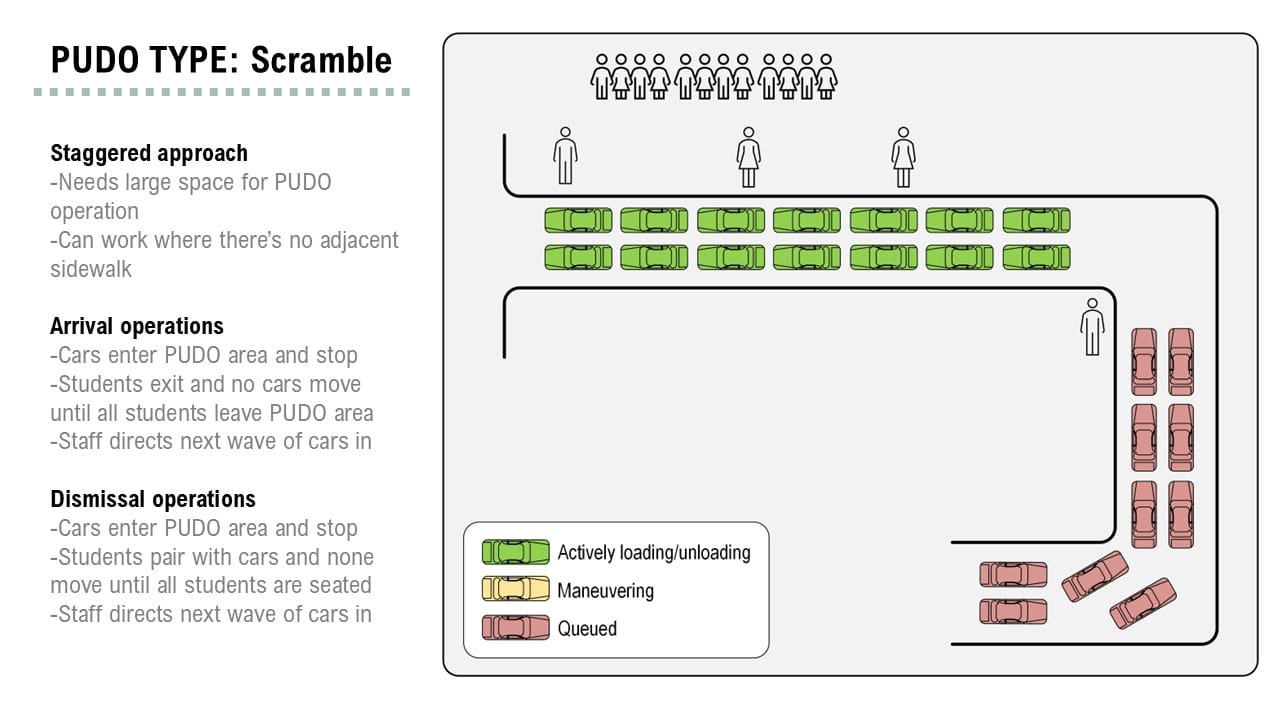
Scramble-style PUDO
When helping plan a school, what does Gorove Slade recommend? In short, all of them. Our recommendation is to design a PUDO facility that can be flexible and work for several operational styles. Once up and running, the staff and teachers can try several and see what works best. The goal is to give them the tools they need to find the best solution.
An example of this is the new Cardinal Elementary School in Arlington, VA. We recommended a flexible system with ample sidewalk and a bypass lane, and once up and running the facility operated a bit differently than planned. At dismissal, teachers split the facility in two, with two pick-up waiting spots – one for younger grades closer to the school, and one for older ones further away. This allowed for quicker matching at dismissal times.
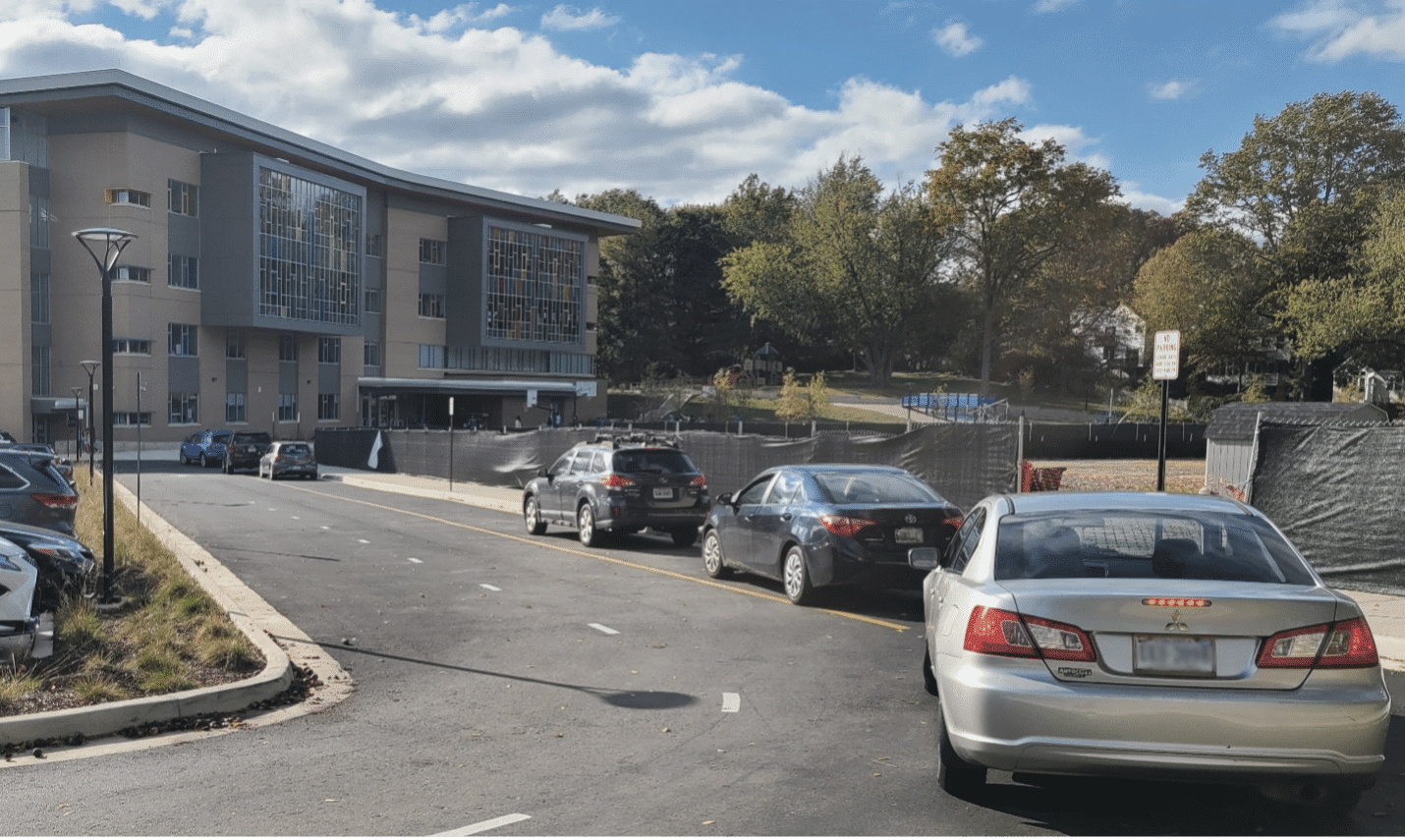
Afternoon pick-up at Cardinal Elementary School
PUDO Analysis
Gorove Slade handles the analysis of PUDO facilities in several ways. They are inherently tricky to analyze because some operational details are difficult to model, and the large amount of demand is very sensitive to variables leading to large ranges of results.
Here are three ways we approach analyzing PUDO:
Queuing Analysis/Equations
One method is to use classic queuing equations, which transportation engineers have been using for decades for things like toll booths. They are based on three factors: the arrival rate of cars, the number of booths, and the processing speed of the toll. All three of these factors correspond to PUDO facilities.
Even so, queuing equations often fail to get accurate results for PUDO facilities. For example, we were working for a private school with a notorious PUDO problem at dismissal, so we went to the field and measured the arrival rate of cars, the number of vehicles that could load at the same time, and the average time for each pick-up. We then entered that information into our queuing models, which then told us the queue should be negative, or in other words, there shouldn’t be a queue at all, as the car arrival rate was less than the overall number of cars that could be processed.
Subsequently, we returned to our observation notes and video. We realized the longest queue in the field was the one when dismissal began, and that our model was correct in that the queue was being processed faster than additional cars arrived. Parents and guardians were arriving so early that they stacked up well beyond the school property, but once dismissal started, the queue only got shorter as more cars showed up.
The lesson we learned here is that there are more factors in the queuing analysis than just the traditional three, and that arrival rates are not random.
Comparable Analysis
A common transportation engineering practice is to study comparable locations, and sometimes, that works well for PUDO facilities, especially when queuing equations don’t work as described above. We’ve taken max queue data at several private and public schools and can try to match the car length per student ratio from a site comparable to the one we’re working on, given the design and operational elements of their PUDO.
There are two issues with using comparable data. The first one is that there’s an extensive range of data, so using our observed data leads to a max queue range of 0.10 to 0.20 cars per student being picked up. The wide range is due to how well the PUDO processes traffic and the starting queue length. To use these ratios, you need to make an estimated guess on how well the PUDO will operate within this range.
But more importantly, our observations found some schools with a max queue under the 0.10 cars per student range during dismissal. This wasn’t because they had fewer cars picking up students; it was because the cars weren’t all in the same place. For example, once the school we observed had around 25 to 30 cars picking up simultaneously, but only 6 were at the official pick-up spot at the front door. The others were in the parking lot, or curbside in several locations. So, when planning PUDO facilities, the ability of parents to use informal locations near the school can be a huge factor in the max queues and overall PUDO operations.
VISSIM Modeling
When something other than engineering judgment combined with the two analyses stiles above is desired, we turn to detailed traffic models using the VISSIM software platform. VISSIM models are highly detailed and can account for things like starting queues, and varying arrival rates. The main drawback is that they require more time and resources to assemble, and in the end still can’t arrive at a perfect representation of a PUDO since human behavior is always a factor.
Thoughtful design and operations can dramatically improve the pick-up and drop-off process. Whether you’re planning a brand new PUDO experience or looking to improve existing operations, the principles and methods discussed here provide a framework for tackling one of the most persistent logistical challenges for administrators and parents alike. By considering key factors like demand patterns, operational strategies, and facility types, schools can create systems that minimize queuing, reduce neighborhood impacts, and make the beginning and end of the school day better for all.
